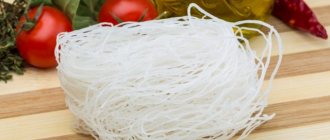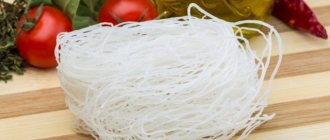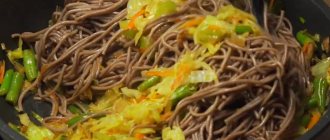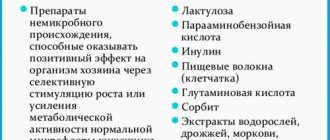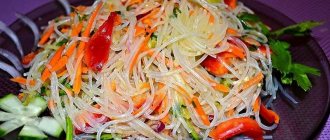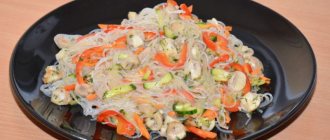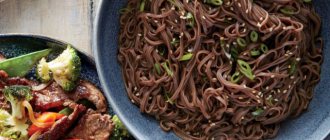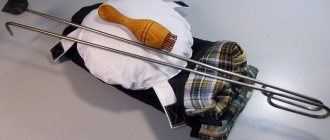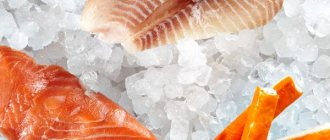Some people simply cannot imagine their diet being completely devoid of pasta. First of all, this is due to the modern lifestyle, and most importantly, to the products that have become commonplace for us.
That is why the topic of our article today will be rice noodles, the calorie content of this product, its features and much more. So, let's begin.
Properties of rice noodles
Nutritional value and composition | Vitamins | Minerals
How much does rice noodles cost (average price per 1 kg)?
Moscow and Moscow region.
333 rub.
Rice noodles are one of the favorite dishes of Asian people, which is common in China and Japan. This product is made from rice flour. It is quite nourishing, elastic and pleasant to the touch, but is practically devoid of a pronounced taste. The calorie content of rice noodles is 364 kcal per 100 grams of dry product.
There is another type of noodle, which in appearance resembles a thin wire - funchoza. Many people believe that it is also a variant of rice noodles, but this is not so - funchose is made from legumes, not rice. In addition, when cooked, rice noodles turn white, but the legume product remains transparent. Homemade rice noodles in their homeland are made very long - this symbolizes the longevity of the owner of the house. As the Eastern proverb says: the longer the noodles, the longer the life.
Today it is not difficult to find rice noodles - they are sold in any supermarket. A high-quality product is distinguished by an almost transparent color with a slightly grayish tint and a slightly elusive nutty smell. If the noodles are cloudy and stuck together, do not take them - such a product will not make a tasty dish.
In cooking, rice noodles are a traditional ingredient in numerous salads and appetizers, as well as Chinese soups. Usually it is not boiled, but soaked for half an hour in hot water before directly preparing the dish. Basically, rice noodles are served with seafood, fried vegetables or meat - smoked or boiled chicken is considered an ideal option. This product goes well with carrots, fresh cucumber or radish. Traditionally, rice noodle dishes are seasoned with soy sauce.
What additives to choose for rice noodles?
According to Eastern traditions, Thai pasta is not salted, but only seasoned with spices and sauces to complete the taste. Most oriental sauces are high in calories - one spoon of soy sauce, for example, will add about 13 kcal to a dish, a similar portion of teriyaki sauce will add from 15 to 20 kcal. This may affect the calorie content of Chinese rice noodles in a negative way.
Rice noodles with shrimp have less calories than chicken noodles
Funchoza goes well with meat, mushrooms and seafood. But if mushrooms and seafood slightly increase its energy value, then the calorie content of rice noodles with chicken will be slightly higher. Adding 100 g of chicken to a dish will increase this indicator by 170 kcal, while 100 g of boiled shrimp will only increase 95 kcal.
If you prepare a dish with stewed vegetables (without oil), you will get a tasty and healthy dish - the calorie content of rice noodles with vegetables will also be about 100 kcal.
When choosing Thai pasta in the store, give preference to unrefined pasta with the addition of bran - the calorie content of Korean rice noodles will be lower, the vitamin content will be higher, and your intestines will receive additional stimulation.
Benefits of rice noodles
Rarely does anyone talk about the dangers of this product, but the benefits of rice noodles are known not only in its culinary homeland, but throughout the world. For example, complex carbohydrates, which are found in large quantities in noodles, enrich human muscle tissue with the necessary energy.
It turns out that this is an excellent product for maintaining your mood and shape. And due to the small amount of salt, it can be consumed by people suffering from kidney, vascular and heart diseases. In addition, the benefits of rice noodles for children and the elderly are obvious, since this product is easily absorbed by the body due to the lack of fiber.
Calories Rice Noodles, Cooked. Chemical composition and nutritional value.
Nutritional value and chemical composition of Rice Noodles, Cooked.
The table shows the nutritional content (calories, proteins, fats, carbohydrates, vitamins and minerals) per 100 grams of edible portion.
| Nutrient | Quantity | Norm** | % of the norm in 100 g | % of the norm in 100 kcal | 100% normal |
| Calorie content | 108 kcal | 1684 kcal | 6.4% | 5.9% | 1559 g |
| Squirrels | 1.79 g | 76 g | 2.4% | 2.2% | 4246 g |
| Fats | 0.2 g | 56 g | 0.4% | 0.4% | 28000 g |
| Carbohydrates | 23.01 | 219 g | 10.5% | 9.7% | 952 g |
| Alimentary fiber | 1 g | 20 g | 5% | 4.6% | 2000 g |
| Water | 73.82 g | 2273 g | 3.2% | 3% | 3079 g |
| Ash | 0.18 g | ~ | |||
| Vitamins | |||||
| Vitamin B1, thiamine | 0.018 mg | 1.5 mg | 1.2% | 1.1% | 8333 g |
| Vitamin B2, riboflavin | 0.004 mg | 1.8 mg | 0.2% | 0.2% | 45000 g |
| Vitamin B4, choline | 1.6 mg | 500 mg | 0.3% | 0.3% | 31250 g |
| Vitamin B5, pantothenic | 0.011 mg | 5 mg | 0.2% | 0.2% | 45455 g |
| Vitamin B6, pyridoxine | 0.006 mg | 2 mg | 0.3% | 0.3% | 33333 g |
| Vitamin B9, folates | 1 mcg | 400 mcg | 0.3% | 0.3% | 40000 g |
| Vitamin E, alpha tocopherol, TE | 0.03 mg | 15 mg | 0.2% | 0.2% | 50000 g |
| Vitamin RR, NE | 0.072 mg | 20 mg | 0.4% | 0.4% | 27778 g |
| Macronutrients | |||||
| Potassium, K | 4 mg | 2500 mg | 0.2% | 0.2% | 62500 g |
| Calcium, Ca | 4 mg | 1000 mg | 0.4% | 0.4% | 25000 g |
| Magnesium, Mg | 3 mg | 400 mg | 0.8% | 0.7% | 13333 g |
| Sodium, Na | 19 mg | 1300 mg | 1.5% | 1.4% | 6842 g |
| Sera, S | 17.9 mg | 1000 mg | 1.8% | 1.7% | 5587 g |
| Phosphorus, P | 20 mg | 800 mg | 2.5% | 2.3% | 4000 g |
| Microelements | |||||
| Iron, Fe | 0.14 mg | 18 mg | 0.8% | 0.7% | 12857 g |
| Manganese, Mn | 0.114 mg | 2 mg | 5.7% | 5.3% | 1754 g |
| Copper, Cu | 38 mcg | 1000 mcg | 3.8% | 3.5% | 2632 g |
| Selenium, Se | 4.5 mcg | 55 mcg | 8.2% | 7.6% | 1222 g |
| Zinc, Zn | 0.25 mg | 12 mg | 2.1% | 1.9% | 4800 g |
| Digestible carbohydrates | |||||
| Mono- and disaccharides (sugars) | 0.03 g | max 100 g | |||
| Essential amino acids | |||||
| Arginine* | 0.155 g | ~ | |||
| Valin | 0.104 g | ~ | |||
| Histidine* | 0.045 g | ~ | |||
| Isoleucine | 0.073 g | ~ | |||
| Leucine | 0.147 g | ~ | |||
| Lysine | 0.062 g | ~ | |||
| Methionine | 0.043 g | ~ | |||
| Threonine | 0.063 g | ~ | |||
| Tryptophan | 0.022 g | ~ | |||
| Phenylalanine | 0.095 g | ~ | |||
| Nonessential amino acids | |||||
| Alanin | 0.1 g | ~ | |||
| Aspartic acid | 0.165 g | ~ | |||
| Glycine | 0.08 g | ~ | |||
| Glutamic acid | 0.329 g | ~ | |||
| Proline | 0.083 g | ~ | |||
| Serin | 0.093 g | ~ | |||
| Tyrosine | 0.094 g | ~ | |||
| Cysteine | 0.032 g | ~ | |||
| Saturated fatty acids | |||||
| Saturated fatty acids | 0.023 g | max 18.7 g | |||
| 16:0 Palmitinaya | 0.021 g | ~ | |||
| 18:0 Stearic | 0.002 g | ~ | |||
| Monounsaturated fatty acids | 0.026 g | min 16.8 g | 0.2% | 0.2% | |
| 18:1 Oleic (omega-9) | 0.026 g | ~ | |||
| Polyunsaturated fatty acids | 0.023 g | from 11.2 to 20.6 g | 0.2% | 0.2% | |
| 18:2 Linolevaya | 0.019 g | ~ | |||
| 18:3 Linolenic | 0.004 g | ~ | |||
| Omega-3 fatty acids | 0.004 g | from 0.9 to 3.7 g | 0.4% | 0.4% | |
| Omega-6 fatty acids | 0.019 g | from 4.7 to 16.8 g | 0.4% | 0.4% |
The energy value of cooked rice noodles is 108 kcal.
- cup = 176 g (190.1 kcal)
Primary source: USDA National Nutrient Database for Standard Reference. Read more.
** This table shows the average levels of vitamins and minerals for an adult. If you want to know the norms taking into account your gender, age and other factors, then use the “My Healthy Diet” application.
General characteristics of the product
Important: There has been confusion in the modern market with rice and glass noodles. These are 2 different dishes with a specific set of ingredients and cooking method
But among the varieties of rice vermicelli there is translucent lifen. It is what they used to call glass, despite belonging to the category of rice products.
Rice noodles have several common names. Among them: starch, Chinese, glass and funchose. The word “funchoza” does not mean vermicelli itself, but the dish that is prepared from it. But locals and lovers of Asian cuisine often use the term specifically to refer to thin strips of rice. This is a traditional dish of the Chinese, Japanese and Korean culinary traditions. Funchoza is prepared from starchy noodles, pickled peppers, branched onions, carrots, radishes and other vegetables. The cook independently determines the set of components and can add meat, mushrooms or other fillings to taste. The dish is served like a regular soup, mostly hot.
Interesting: funchose can be prepared in stages, like any multi-component dish, or you can buy instant noodles. The manufacturer places 1 serving of rice product and a bag of dried vegetable seasonings inside the package. The quality of instant noodles is a controversial issue that depends on the cost of the product, composition and policy of the manufacturer.
Asian paste for funchose is prepared from mung bean starch. Mung beans (mung beans) are an annual herbaceous plant from the Legume family. It is believed that the birthplace of the culture is India. Small green seeds, which look very similar to peas, have filled the whole world. Their level of consumption is not inferior to chickpeas and other legumes.
Mung bean is not the only source of starch. On an industrial scale, potato starch, cannas (an annual forage plant), cassava (an edible tropical plant) or yams (a legume similar to a giant potato) are often used. To reduce the cost of production, bean starch is also replaced with corn starch.
Traditional rice vermicelli has a round cross-section when cut. The diameter of each strip may vary due to production characteristics. Dried noodles are added to salads, soups, deep-fried appetizers and other dishes.
Interesting: dry rice vermicelli is colored white, but after heat treatment it becomes translucent.
Rice noodles are prepared using a special technique - an extruder. Layers of dough are passed through the unit, and the output is thin strips, which must be further processed and wrapped in packaging. Less often, a sheet of dough is simply evaporated from a flour solution and cut into strips yourself. The second option is more labor-intensive and takes longer. Salt is not added to traditional vermicelli, but modern manufacturers most often add it to the composition.
Best articles Rice with chanterelles
Types of food component:
- Guotiao. Flat strips of rice flour that look very similar to Italian fettuccine.
- Shahefen. Wide flat strips of noodles. Similar to Italian pappardelle pasta.
- Laifen. Thick round translucent vermicelli. Prepared with sticky rice. The shape is identical to the spaghetti we are used to.
- Misian. Long, thinnest white strips, similar to spaghettini.
Funchoza with vegetables and mushrooms.
The Chinese dish funchoza with vegetables and mushrooms is very popular in Chinese restaurants. Funchoza is a Chinese pasta made from rice flour. Such rice pasta is considered a dietary product; it is easily digestible, so it can be used for baby food and for those who are watching their figure.
Funchose is a traditional ingredient in many Chinese dishes, but today we will prepare funchose with stewed vegetables and mushrooms and we will need the following products:
- funchose - in the form of noodles or vermicelli - 250 grams
- small onion
- medium sized carrot
- small zucchini
- Bell pepper
- fresh tomato
- boiled mushrooms (white or champignons) - 250 grams
- Chinese cabbage - 100 grams
- ginger root - 30 grams
- 2 tablespoons soy sauce
- 3-4 small cloves of garlic
- table salt and ground black pepper
- vegetable oil
- greenery
Preparation: pour 1.5 liters of water into a saucepan, put it on the fire, when it boils, add a little salt, put the funchose in it, cover with a lid and remove from the heat. After 7 minutes, place the pasta in a colander to drain all the water.
While the fuchoza is preparing, let's start preparing the vegetables. There is no need to cut them all at once; we will prepare them in a certain sequence. And so, put finely chopped onion in a hot large frying pan, while it is fried over medium heat, peel and grate the carrots and add it to the onion, cut the zucchini into strips, add to the frying pan, do not forget to stir periodically. Then we chop one by one and immediately put the sweet peppers, mushrooms, cabbage, garlic, peeled tomato, salt, ground pepper, and ginger into the pan. Simmer all this under the lid for another 5 minutes, remove from heat, add funchose to the vegetables, pour in soy sauce, and mix. Place the prepared funchose with vegetables and mushrooms on a plate and serve, garnished with chopped herbs.
